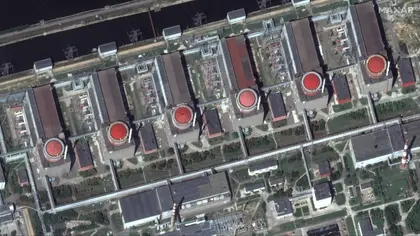The International Atomic Energy Agency (IAEA) is seeking to dispatch a team to the Zaporizhzhia Nuclear Power Plant no later than September 5.
Quoting various diplomatic sources with knowledge of the plans, Bloomberg reports that the team will consist of security and safety authorities to tag-along with the Agency’s nuclear experts. It is thought that the security experts would be able to do forensic analysis to determine whether it was Ukrainian or Russian troops who have been firing on the NPP over the recent months, triggering alarm globally.
JOIN US ON TELEGRAM
Follow our coverage of the war on the @Kyivpost_official.
The quoted diplomatic sources went on to say that an “impending International Atomic Energy Agency visit to the Zaporizhzhia Nuclear Power Plant in southern Ukraine will include security and safety authorities, in addition to the officials in charge of accounting for nuclear material at the site”. The two diplomats with knowledge of the visit asked not to be identified in exchange for discussing the plans.
The Zaporizhzhia NPP, the largest operating nuclear power plant in Europe, has been the source of sustained international attention and concern, as Russian soldiers have continued to occupy the plant and its surroundings since soon after the full-scale invasion of Ukraine began on February 24.
Even before the outbreak of the war, international nuclear authorities had been planning a two week working visit to the NPP – the first such visit in over a decade-and-a-half. Such visits allow for the IAEA to ensure that the working of the plant is in accordance with the international standards and norms.

Trump’s 90-Day Foreign Aid Freeze Won’t Apply to Ukraine Military Funding, Pentagon Assures VOA
According to Ukraine’s nuclear authorities, earlier this week the Zaporizhzhia NPP was disconnected from the grid. Nuclear reactors must have stable sources of electricity and water to prevent accidents and from melting down.
In an interview with the Kyiv Post, Nicolas Woods, a former US Navy submarine officer and nuclear engineer said: “If the plant workers are unable to do their job of maintaining the reactors safely and providing reliable electricity, or if the plant undergoes risk of physical destruction from military attacks, there will be a high risk of either damage to the nuclear reactor cores or possible breach of containment.”
The worst case scenario, according to Woods, would be a breach “of containment of any of the nuclear reactors”, which he states would “release nuclear radioactivity into the environment. This will not only have an impact on the local area but if released airborne, the radioactivity could spread to all over Europe. While the reactors are well- protected with lead shielding to protect the plant workers, it does not serve as a missile shield.”
You can also highlight the text and press Ctrl + Enter










